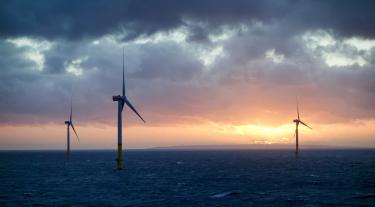The Offshore Renewables Joint Industry Programme (ORJIP) for Offshore Wind is a collaborative initiative that aims to:
- fund research to improve our understanding of the effects of offshore wind on the marine environment
- reduce the risk of not getting or delaying consent for offshore wind developments
- reduce the risk of getting consent with conditions that reduce viability of the project
The programme pools resources from the private sector and public sector bodies to fund projects that provide empirical data to support consenting authorities in evaluating the environmental risk of offshore wind. Projects are prioritised and informed by the ORJIP Advisory Network that includes key stakeholders such as statutory nature conservation bodies, academics, non-governmental organisations and others.
ORJIP projects focus on priority consenting risks in the UK, with learnings applicable to other geographies.
Stage 1
Stage 1 of the programme ran from 2012 to 2018 and was managed by the Carbon Trust and funded by The Crown Estate, Marine Scotland and Crown Estate Scotland, with additional developer funding for individual projects. Major studies included an investigation into the efficacy of acoustic deterrent devices on different marine mammals and a pioneering, two-year study to record and quantify the avoidance behaviour of seabirds around offshore wind farms.
Stage 2
Stage 2 was launched in 2019 and will run until 2023, with an option to extend the programme up to 2025. There are currently 10 research projects being progressed at different stages, each with a project expert panel (PEP) of key industry stakeholders to support its scoping and delivery.
Year 1 projects
- Review of current and planned monitoring of seabird behaviour across operational wind farms (SBMon): evaluate available and planned data, technologies and approaches used to gather and analyse evidence, with the objective to improve collision risk models, so they provide a holistic picture across species, seasons and geographical locations.
- Improving quantification of mortality rates associated with displacement within the assessment process: provide more ecologically and geographically informed estimates of displacement-related mortality rates by species.
- Improving methods for apportioning seabirds seen at sea both in the breeding season and non-breeding season (AppSaS): reduce uncertainty in how the offshore wind sector apportions seabirds recorded during at-sea surveys. This will enable more robust pre-consent impact assessments by:
- reviewing current approaches to apportioning by using empirical data and other evidence sources to validate the assumptions that underpin these methods.
- suggesting improvements to existing approaches or, if required, developing new approaches.
- Reducing conservatism in underwater noise assessments (ReCon): recommend improvements to noise risk assessments, across collection and reporting of noise monitoring, and modelling impact predictions. It involves the collection and review of real-world underwater noise data measured during piling installation to analyse the differences in noise levels, frequency, duration, etc. for different piling methodologies, strategies and environments.
- Bird Sensitivity Mapping Phase II (BSM P2): Further develop the ‘Seabird Sensitivity Mapping Tool’, created under Stage 1 to:
- extend its geographical coverage to the rest of the United Kingdom
- improve the scope of the tool
- increase the tool’s flexibility
Phase 2 is sponsored by Marine Scotland and the Offshore Wind Evidence and Change (OWEC) programme.
Year 2 projects
- Data integration of tracking and at-sea survey data (InTAS): develop a framework to integrate GPS tracking and at-sea survey data, to estimate the proportion of breeding birds within at-sea surveys, with proper quantification of uncertainty.
- Improving the evidence base for coexistence between commercial fishing and offshore renewables – a focus on cabling (CoEx): understand the operational risk of fishing over subsea cables considering seabed conditions, geology and seabed morphology. This research will provide practical evidence to support risk assessments and improve safety of fishing activity near offshore wind cables.
- Effects of displacement from Offshore Renewable Developments in the non-breeding season (DisNBS): Develop a simulation model that predicts the time/energy budgets of seabirds during the non-breeding season, and translates these into projections of adult annual survival and productivity.
- Range dependent nature of impulsive noise (RaDIN): develop a framework for use in noise impact assessments that a) assesses the impulsivity of noise with range from the source and b) the subsequent risk of injury to marine mammals.
- Monitoring of Cable Protection Measures (MonCP): analyse the impact of cable protection measures on marine ecology, bringing together new and existing evidence to inform environmental assessments.
Year 3 & 4
Following a rigorous assessment of evidence needs and priority areas for research, ORJIP is focusing on delivering research projects to reduce consenting risk through common research projects and larger discretionary projects. The programme will assess the impact of the research in mitigating consenting risks, and additionally review the potential for environmental innovation within the offshore wind supply chain to address the priority issues identified by ORJIP during Stage 2.
ORJIP Offshore Wind Stage 2 partners

Contact us
To find out more contact ORJIP@carbontrust.com


